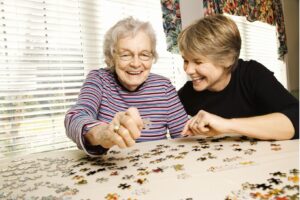When Alfred began showing early signs of dementia, his family was deeply concerned about what to do. How quickly would his mental condition deteriorate? Would they be able to communicate with him for much longer? These questions swirled in their heads, as 70-year-old Alfred began to struggle with speech and memory. He gradually became more and more withdrawn, his interaction with family diminishing as time went on.
A visit to his doctor proved to be a turning point, when it was suggested that Alfred try movement therapy to combat his dementia. During his younger years, he had been extremely active—he played lots of sports, and was part of a rock band. His daughter often reminisced about her father’s love of playing music; it had made him happy in a way that seemed to now be permanently left in the past. So when she accompanied her dad to his first movement therapy class, what she saw brought tears to her eyes: there was Alfred, bobbing his head, waving his arms to the sky, and grinning from ear to ear.
What Is Movement Therapy?
Movement therapy is all about moving your body authentically. While it’s a form of creative expression that works at any age, it’s particularly great for older adults with dementia. Unlike dance, there are no choreographed motions to memorize or patterns to follow. There is no right or wrong in movement therapy: the entire point is to enjoy moving your body however you desire. In this way, it creates feelings of freedom, relaxation, and sometimes even catharsis in participants.
As therapist Gina Serraino explains, “everyone speaks the language of movement.” If your loved one suffers from dementia, movement therapy offers an alternative to talk therapy. By moving freely, your loved one can release emotional, mental, and physical tension without needing to engage in conscious thought. The entire experience is centered around having fun in the moment.
How Does it Help People with Dementia?
Research has shown that expressive movement is able to conjure memories in people without requiring them to think. In this way, movement therapy gives those with dementia an outlet to access different emotions. The goal of participating in movement therapy is to optimize your loved one’s quality of life—and there are many ways in which it does this.
Stimulates memory
“Memories are stored in the muscles of the body, and moving can draw those memories out,” says movement therapist Donna Newman-Bluestein. Trained therapists are able to connect with your loved one through movement, and stimulate memory by using tactile props and other techniques. Hearing a certain song while moving authentically also can prompt happy memories from your loved one’s past. Further, simply being active can help with memory: “recent studies have shown that exercise may improve memory and slow down mental decline.”
Exercises the whole body
During a movement therapy session, therapists will encourage your loved one to use many different parts of their body—especially ones that are underused, like the neck, ankle joints, arms, and fingers. This helps to increase circulation throughout their entire body, and keep them fit while having fun. Doctors have known for some time now that exercise is really beneficial for dementia. It can help your loved one remain engaged in the activities of daily life by improving their sleep habits, overall strength, and ability to perform everyday tasks.
Involves music
There’s plenty of research to show the benefits of music for older adults with dementia. Songs not only evoke memories, but can positively impact your loved one’s outlook on life. The combination of movement and music is healing: the Alzheimer’s Foundation of America explains, “When used appropriately, music can shift mood, manage stress-induced agitation, stimulate positive interactions, facilitate cognitive function and coordinate motor movements.” In addition, your loved one’s aptitude for and appreciation of music often remains strong, even when suffering from dementia.
Creates a shared experience
An important aspect of movement therapy is its group setting. Your loved one will have quality time to connect with others with dementia, which can lessen isolation, reduce depression, and increase self-esteem. Classes are often led in a circle, allowing for eye contact between participants and enhancing the shared experience. There’s no doubt about it: “being social is an essential part of one’s brain health with healthy diet and exercise.”
With so many incredible benefits to movement therapy for dementia, this is a really worthwhile activity for your loved one to try. Happily, San Francisco offers numerous options. Local organizations and community centers are good places to start, as many offer low-cost programs specifically tailored toward those with dementia. Movement therapy for dementia can be extremely impactful, and offers many rewards. At its best, it can provide a gateway for your aging loved one to reconnect with their bodies, other people, and life itself.
If you’d like more resources to help your loved one navigate life with dementia, Institute on Aging is here to support you. Contact us today to find out how we can help improve your loved one’s quality of life.







